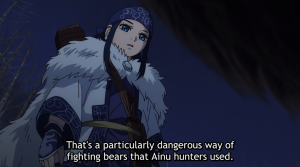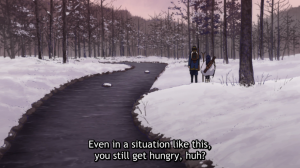84 Golden Kamuy (2018- )
Shifting Japanese Cultural Attitudes in Golden Kamuy
By Trace White
Golden Kamuy is a Japanese animated series based on the manga written by Satoru Noda. Golden Kamuy is an action-packed series with humorous gags and a mysterious plot. But, the accurate depictions of the people involved in the Russo-Japanese War, and mainly the Ainu people, shine beyond all of this. The story highlights gender inequalities, intersecting cultures, and class difference. The reason I picked Golden Kamuy as my DPD topic was this heavy focus on the Ainu people and the way they live, adapt, and had to assimilate into Japanese culture. The two main characters, a Japanese soldier and a young Ainu woman, form an unlikely friendship and struggle to survive while unraveling a mysterious puzzle – all while continuously learning about each other’s culture and personal beliefs. The scenery, clothing, and differences in language are highlighted, bringing a refreshing authenticity to the series.
The story begins in 1904, the post-Edo, Meiji era of Japan. The first focus is of a Japanese soldier in the Russo-Japanese war, Sugimoto Saichi, fighting an unwinnable war against machine guns and cannons, but becoming one of the only survivors – this deems him the title “immortal” Sugimoto. This scene is followed by introducing the basic plot to us through a story. Sugimoto is alone in the mountains with an older man who begins to tell a story about lost, mountains of gold. This older man tells the story of the Ainu and how they gathered and stored a mountain of gold in order to fight the Japanese to protect their right to live off the land and maintain their culture. Then, a single man killed the Ainu and stole all of the gold and was sentenced to a life in prison after he hid it. In order to spread the information of the gold’s location from within the walls of a prison, this man began tattooing other prisoners in a cryptic “map” or code, over their whole torso, telling them to escape and claim half the gold for themselves. What the old man describes next sets the tone for the show and the basis of the plot. To find the gold, you need all of the tattoos, which drove the greed of the prison guards, giving the inmates a chance to escape when they were taken out of the prison for this gold hunt.
This whole storytelling scene rapidly goes through frames while still feeling cohesive, guiding us through this tale. It begins to display how people are used as tools and highlights how the Ainu were not seen as people with rights in Japan. Back to Sugimoto in the mountains, this is when he finds the corpse of the old man that told him the story of the Ainu and their gold. It appeared that the old man was attacked and killed by a bear. Looking at the body, Sugimoto sees a very unique tattoo covering the man’s body and understands why the old man knew such a detailed story. Putting the body on his back Sugimoto is off in an attempt to preserve the body before the bear comes back to finish its meal. This is when we are introduced to our second lead in the story, the Ainu woman Asirpa, who rescues Sugimoto as the bear begins to chase him down. Asirpa is a small woman with blue eyes in traditional Ainu clothing and a bow. She is usually displayed in a close-up or waist-up shot, and these frames always give great detail when displaying her colorful clothing and jewelry. This is a welcoming contrast to Sugimoto and even the other Ainu that are displayed, generally having fairly plain or colorless clothing.
Asirpa shoots the bear with a poison arrow, allowing them to escape the dire situation. After this interaction, we delve head first into the intersections of differences in culture. Asirpa cuts out the section of the bear with the arrow and explains that the poison will ruin the meat and pelt if it’s allowed to stay. Asirpa acknowledges the dead man and Sugimoto explains that he assumes the man was killed by the bear. This leads us into another lesson when Asirpa explains that during this time of year when bears first leave hibernation their stomachs are too small to eat large amounts and avoid eating people because of this – cutting open the stomach to display it being small and empty. She then introduces the Ainu concept of the Matakarip, which in their language means “those that wander in winter” – bears who are hyper-aggressive and failed to hibernate.
This leads the conversation to what Sugimoto is going to do with the body of the old man and Asirpa displays her concern that bringing the man to town will just lead this Matakarip into a populated area. She asks him to just leave the body and Sugimoto exclaims that he cannot do that, then begins to tell Asirpa the story of the Ainu and the gold. Asirpa immediately believes his and proclaims that she understands because her father was one of those prisoners. Later around the fire, getting ready to lure in the dangerous Matakarip, Asirpa comments on how cruel the tattoos are, noticing that the breaks in the pattern are along the lines in which you would normally skin an animal. This sets a dark tone for the show but brings to light how someone might gather so many pieces of this code and is another intersection of culture displaying something Sugimoto had no concept of.
Next is a life or death struggle between them and this ferocious Matakarip. Asirpa praises Sugimoto for using an old Ainu hunting technique of falling into ones back and letting the bear jump onto a spear, or in this case a bayonet. The series does an amazing job in drip feeding us information about the Ainu people and displays a clear difference in culture between the two. Language is often highlighted as being a factor of misunderstandings and often relates to food.

After formal introductions, Sugimoto skins the tattooed man and asks Asirpa if she would like to help him find the gold, while discovering who killed her father – setting the scene for these very different people working together and learning from each other. Sugimoto wants money to live and Asirpa wants revenge. “In the second chapter of volume 1, Asirpa explains to Sugimoto that any animals/kamuy–a bear in this case– attacks or kills a human it becomes a wenkamuy (evil god). The Ainu do not consume animal gods that have killed humans nor do they take their fur to make use of it.” (Sengundo 2017) Going forward we learn an amazing amount about the Ainu people and their survival techniques, mainly food. There is a scene in episode 3 where Asirpa is teaching Sugimoto how to make Chitatap, a meal of squirrels, chopping the entire body and bones into paste before cooking it. Asirpa offers Sugimoto the brain, and though he displays how weird he thinks that is, reluctantly accepts pretending to like it. Despite being put off by eating a brain, Sugimoto continues his interest in Asirpas cooking lesson and always asks questions regarding linguistic differences, like “hinna hinna” a phrase Asirpa uses to display enjoyment for food, or even praise the food itself. It’s compared the Japanese phrase “itadakimasu” which means “to eat and receive” and essentially is the same as “hinna hinna”, giving thanks and appreciating what is before them.
Sugimoto begins asking why a woman is out on her own and praises Asirpa for how capable and talented she is. This is where we get an explanation of how Asirpa is trying to break away from her own culture, something she holds dear, and wants to be a different type of Ainu woman. She wants to be whatever she wants to be, someone unbound by gender roles and cultural expectations, someone strong like her father. The show never delves too hard into gender inequality but it alludes to enough for us as the viewer to understand that Asirpa wanting to be a different kind of Ainu woman is a powerful statement. This is another reason why her clothing is a great indicator as to how unique, or how strong she is as a person.
The conversations these two have are a lot of give and take. They both find each other pretty odd and this is brought to light a lot in a lighthearted way focused around food. Asirpa sees Sugimoto adding miso to his food and is disgusted by the fact that he is adding what looks like deer poop to his food. Even after he explains what it is, this becomes a long running joke that Sugimoto likes to eat poop. For as dark as the story can be at times, these moments add a very human element to the story and interactions between the two. “In an interview for the Asahi Shimbun, Nakagawa expresses respect for the Noda’s dedication in research. “I was surprised how he drew (the characters) to the finest details. If I were to create a textbook on the Ainu, I would love to publish this artwork.” Though rigorous research was done to ensure an accurate representation, in the same interview Noda cautioned against the dangers of over-romanticising them. When depicting members of a minority, quite often authors describe them as innocent or honorable. In fact, these are the very traits that make readers root for these characters. But over-reliance on these stereotypes can easily come off as shallow characterization. In Golden Kamuy, just as there are Ainu characters who are honorable warriors, there are also characters who are sly and deceitful.” (Sakura 2019)
What stands out next to the cultural differences displayed in conversations is the scenery we are given and how it pairs well with the tone of each episode. A lot of shots done outdoors use a wide angle and have a focus that isn’t the main characters, attempting to display how large the world is. In the screenshot displayed below we see the river and trees being a large focus with the characters being very small, and even drawn with less detail. The snow and distant trees have a texture that adds a bit of realism to the shot and feels very inviting despite the climate displayed being very harsh.

Golden Kamuy is a historical action mystery that stays true to the roots of inspiration. It teaches us about difference, acceptance, and overcoming adversity within changing, intertwining Japanese cultures. In regards to DPD topics, it touches on nearly everything while also never delving too deep and becoming stale or preachy. The story is enticing and drip feeds its watchers/readers cultural information, accurate history, and the connections that can be made when we accept each other for who we are. After researching information for this paper, I have a much deeper respect for the author and his attempt to accurately depict the Ainu people – a people that have only recently been accepted as natives to Japan. I highly recommend this story to anyone interested in an engrossing story with accurate depictions of the Ainu people and their struggle to keep their culture in an ever-changing world.
REFERENCES
Maari Sugawara, et al. “‘Golden Kamuy’ Shedding Light on Japan’s Indigenous People Ainu.” JAPAN IN CANADA, 2 June 2020, japanincanada.com/golden-kamuy
Sakura T. “Ainu Representation in ‘Golden Kamuy.’” The International, isshinternational.org/5845/arts-and-entertainment/ainu-representation-in-golden-kamuy
“Golden Kamuy.” Wikipedia, Wikimedia Foundation, 20 Feb. 2021, en.wikipedia.org/wiki/Golden_Kamuy
Demers, Matt. “Golden Kamuy, Culture, and Authenticity.” MattDemers.com, mattdemers.com/golden-kamuy-authenticity
Sari, Ida Ayu Laksmita, and Wanda Listiani. “PROMOTING JAPANESE CULTURAL TOURISM THROUGH APPRECIATION OF AINU FOLKTALES AND ANIME.” International Conference on Fundamental and Applied Research (I-CFAR), jurnal.undhirabali.ac.id/index.php/icfar/article/view/926/828
Cheung, S.C.H. “Ainu Culture in Transition.” Futures, vol. 35, no. 9, 2003, pp. 951–959., doi:10.1016/s0016-3287(03)00051-x

